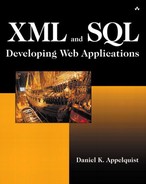Summary
In this chapter, I discussed the features of Microsoft SQL Server 2000 that enable you to work with XML and relate XML documents and SQL Server database objects. I showed you several ways to retrieve data, including the FOR XML clause, templates, XML views, and XPath queries.
You learned how to communicate with SQL Server across the HTTP protocol by formatting your requests, using various methods, in XML. I also discussed some tips and tricks that should make building XML views simpler than writing them entirely by hand.
Finally, the OPENXML feature enables you to open XML documents on SQL Server so you can query and insert data into your databases directly from the XML documents. Still more features are available with SQL Server. I recommend that you explore them if you find that implementing XML processing on your database server is appropriate for the requirements of your projects.
While this chapter has illustrated some of the mechanics of how one vendor has married XML and SQL databases, other major database vendors, such as Oracle, also offer features for integrating XML and relational databases. With this knowledge in hand, you should be well prepared to begin exploring the features of your favorite server in greater depth for whatever applications you choose to build.
